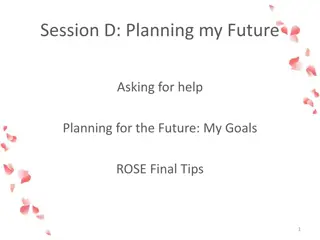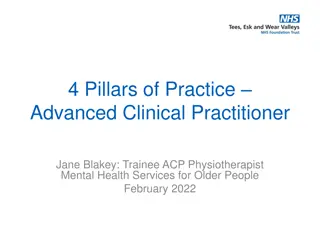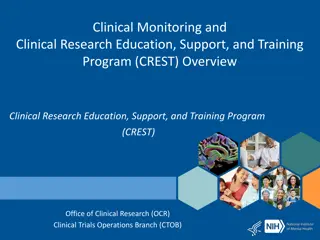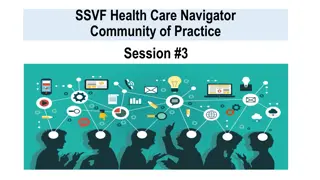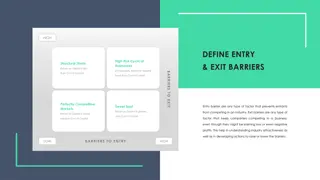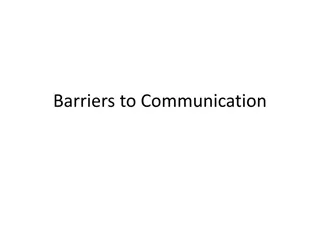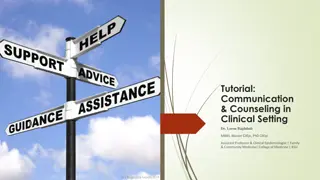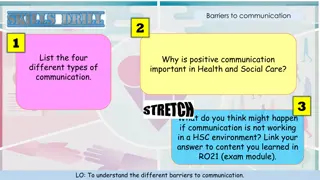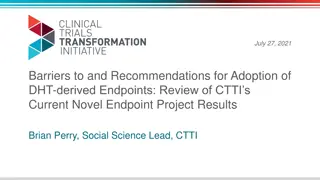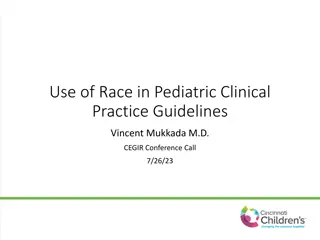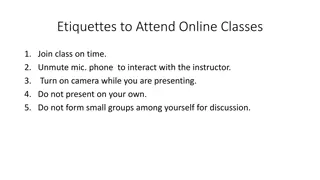Overcoming Barriers in Clinical Practice
Dive into the challenges faced in high-value care delivery, explore ways to overcome barriers, assess the efficacy and safety of medical interventions, manage patient expectations, and make informed decisions based on case studies and research findings.
Download Presentation

Please find below an Image/Link to download the presentation.
The content on the website is provided AS IS for your information and personal use only. It may not be sold, licensed, or shared on other websites without obtaining consent from the author.If you encounter any issues during the download, it is possible that the publisher has removed the file from their server.
You are allowed to download the files provided on this website for personal or commercial use, subject to the condition that they are used lawfully. All files are the property of their respective owners.
The content on the website is provided AS IS for your information and personal use only. It may not be sold, licensed, or shared on other websites without obtaining consent from the author.
E N D
Presentation Transcript
Overcoming Barriers Fellowship HVC Curriculum 2016-2017 Presentation 5 of 7
Learning Objectives Describe the barriers to high value care in clinical practice and explore ways of overcoming these barriers. Weigh the efficacy and safety of medical interventions to avoid inappropriate use and harm. Explore barriers that interfere with successful patient care and how to help reduce these barriers. Explain the importance of managing the expectations of patients and referring physicians in the disposition of the patient.
Case #1 Back Pain Chief complaint: My back hurts and I was told a vertebroplasty would take care of the pain 72-year-old woman presents with severe acute low back pain that happened while lifting a box. She denies radiation to the legs, weakness, numbness, bowel or bladder incontinence, or any other neurological symptoms. PMH: Unremarkable Medication: Rarely takes calcium or vitamin D Social/Family Hx: Retired teacher, occasionally uses alcohol, does not smoke
Back Pain Physical Exam (including neurologic exam): Normal except for point tenderness over the lumbar spine. BMI 21. The radiologist who may do the procedure has seen her and you have been consulted to help with her osteoporosis management.
Small Group Questions Do you think a vertebroplasty would benefit this patient? How would you discuss the vertebroplasty with the patient and the primary service depending on your impression of its benefit?
Efficacy of Vertebroplasty Two randomized studies have not demonstrated a benefit of vertebroplasty over sham vertebroplasty.1,2
What Has Happened After Publication? From 2004-2008, vertebroplasty and kyphoplasty discharges increased by 427% and 470% respectively.3 In 2010, after the NEJM papers, the volume of these procedures fell.4 However, there might be a window when the procedure helps.5
Case #2 I need a Thyroid Test Chief complaint: My cousin has Thyroid cancer and I need a test. 48-year-old woman presents with no symptoms, but since her cousin told her she was diagnosed with thyroid cancer, the patient thinks she has a lump in her neck which she thinks is cancer. Neg PMHx, no meds, no allergies No family history of cancer other than her cousin She works as a hospital administrator and has no history of radiation exposure PE: normal vitals, exam is normal including a normal-size thyroid with a nodule that measures to be about 1.5 cm on palpation
Thyroid The patient has a TSH in the normal range An ultrasound is obtained which shows a 1.2 cm nodule which is read as low suspicion for malignancy
What Test Would You Order? Which tests would you order or not order? What guides your decisions in this? How do you explain this to the patient? How can guidelines help in your decision and explanation to the patient?6
Thyroid Nodules New guidelines use TSH and other risk factors as well as size and sonographic appearance of nodules on ultrasound to determine the need for a fine needle aspiration.6 This patient, prior to the fall of 2015, would have had a biopsy, but now would wait until a change in her nodule size or appearance to obtain a biopsy. How does the patient and physician practice a strategy of observing rather than doing? How do you keep the patient from going elsewhere to find someone who would do the biopsy, even if that is not consistent with the current guidelines?
What are the potential barriers to high value testing? Lack of guidelines Poor familiarity with guidelines Lack of knowledge of costs, including the impact of setting on cost Defensive medicine (i.e. fear of litigation) Time pressure (emphasis on shorter LOS and productivity) Explaining to patients why tests/treatments are not indicated takes time Discomfort with diagnostic uncertainty Local standards of care Misaligned financial incentives Lack of appreciation of harms Referring physician expectations Patient expectations Lack of centrally available information on prior tests
Case #3 You see a patient in clinic for obesity. She has been overweight from age 18 and has become obese over the last 10 years. She states she is exercising regularly and barely eats 1000 calories a day. In fact, her dietitian has told her she needs to eat more. She is convinced that there is a treatable hormonal cause of her obesity and wants you to work her up for this, especially for Cushing s syndrome which she has read about on the Internet.
Case #3 Her history does not suggest a rare cause of obesity, such as Cushing s syndrome. On physical exam, she has obesity, but no stigmata of Cushing s Syndrome. How do you handle her request?7
Potential Barrier: Patient Expectations Patients often think that more testing is better Physicians have legitimate concerns about patient satisfaction, which may be tied to reimbursement
Talking to patients about NOT doing things Principles of patient-centered discussions: Find out where the patient is coming from What are you afraid we will find? What do you think is going on and what are you worried about? Explain your reasons The good news is that you don t have any worrisome symptoms. Make it clear that you are on the patient s side I wish more testing would help you, but it could actually make things worse. Contract for a clear follow-up plan and review red flag signs and symptoms I want to see you in 6 months, but call sooner if there are changes that concern you.
Small Group Work 1) Discuss how we explain to the patient when a work up for a secondary cause of a chronic disease is unlikely to yield a treatable diagnosis. 2) When should you perform the work up for a secondary cause? 3) What are other cases where over-testing and over-diagnosis are common?
Patient Adherence You have been referred a 45-year-old woman with obesity, hypertension, and diabetes because her PCP has had trouble getting her A1c below 11%, even on insulin. She has seen you in clinic after missing the first scheduled appointment with you. During the course of your initial visit, you identify that she misses doses of her insulin at least 2-3 times a week. You adjust her insulin regimen and ask her to see you again in a month. She misses her next appointment, but shows up 3 months later with no change in her A1c and no change in her adherence to her insulin regimen.
Discussion Questions Identify barriers to this patient coming to her appointments.8,9 Identify reasons why this patient may not be adherent with her medications, especially insulin.10 Are there strategies to help improve these issues?11
Strategies to Overcome Barriers Maintain open lines of communication with your patients around their logistical and financial barriers to care and their healthcare workload Always frame the conversation that you are trying to understand things from their perspective and that you are concerned about them Don t expect yourself to have all the answers; use the expertise of social workers, case managers, navigators, and others to help patients overcome barriers to care
QI Commitment in Your Practice Consider how barriers to high value care affect your practice. List at least one thing to start doing and one thing to stop doing. START: STOP:
References 1. Buchbinder R, et al. A randomized trial of vertebroplasty for painful osteoporotic vertebral fractures. N Engl J Med. 2009 Aug 6;361(6):557-68. 2. Kallmes DF, et al. A randomized trial of vertebroplasty for osteoporotic spinal fractures. N Engl J Med. 2009 Aug 6;361(6):569-79. 3. Leake CB, et al. Trends of inpatient spine augmentation: 2001-2008. AJNR Am J Neuroradiol. 2011 Sep;32(8):1464-8. 4. Long SS, et al. Vertebroplasty and kyphoplasty in the United States: provider distribution and guidance method, 2001 2010.AJR Am J Roentgenol. 2012Dec;199(6):1358-64. 5. Wardlaw D, et al. Efficacy and safety of balloon kyphoplasty compared with non-surgical care for vertebral compression fracture (FREE): a randomised controlled trial. Lancet. 2009 Mar 21; 373(9668):1016 24. 6. Haugen BR, et al. 2015 American Thyroid Association management guidelines for adult patients with thyroid nodules and differentiated thyroid cancer: the American Thyroid Association Guidelines Task Force on Thyroid Nodules and Differentiated Thyroid Cancer. Thyroid. 2016 Jan;26(1):1-133. 7. Baid SK, et al. Specificity of screening tests for Cushing s syndrome in an overweight and obese population. J Clin Endocrinol Metab. 2009 Oct; 94(10):3857-64. 8. Lacy NL, et al. Why we don t come: patient perceptions on no shows. Ann Fam Med. 2004 Nov-Dec;2(6):541-5. 9. Syed ST, et al. Traveling towards disease: transportation barriers to health care access. J Community Health. 2013 Oct;38(5): 976-93. 10. Karter AJ, et al. Barriers to insulin initiation: the translating research into action for diabetes insulin starts project. Diabetes Care. 2010 Apr;33(4):733-5. 11. Molfenter, T. Reducing appointment no-shows: going from theory to practice. Subst Use Misuse. 2013 Jun;48(9):743-9.















